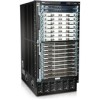Dell PowerConnect J-8216 Hardware Guide - Page 195
Maintaining Fiber-Optic Cables in J-EX Series Switches
 |
View all Dell PowerConnect J-8216 manuals
Add to My Manuals
Save this manual to your list of manuals |
Page 195 highlights
Chapter 14: Routine Maintenance • Place excess cable out of the way. Do not allow fastened loops of cable to dangle from the connector. Placing fasteners on the loops helps retain their shape. • Keep the cable connections clean and free of dust and other particles, which can cause drops in the received power level. Always inspect cables and clean them if necessary before connecting an interface. • Label both ends of line card cables to identify them. Related • Handling and Storing Line Cards in J-EX8200 Switches on page 175 Documentation • Maintaining Fiber-Optic Cables in J-EX Series Switches on page 179 • 8-port SFP+ Line Card in a J-EX8200 Switch on page 32 • 48-port SFP Line Card in a J-EX8200 Switch on page 33 • 48-port RJ-45 Line Card in a J-EX8200 Switch on page 34 Maintaining Fiber-Optic Cables in J-EX Series Switches Fiber-optic cables connect to optical transceivers that are installed in J-EX Series switches. To maintain fiber-optic cables: • When you unplug a fiber-optic cable from a transceiver, place rubber safety caps over the transceiver and on the end of the cable. • Anchor fiber-optic cables to avoid stress on the connectors. When attaching a fiber-optic cable to a transceiver, be sure to secure the fiber-optic cable so that it is not supporting its own weight as it hangs to the floor. Never let a fiber-optic cable hang free from the connector. • Avoid bending fiber-optic cables beyond their minimum bend radius. Bending fiber-optic cables into arcs smaller than a few inches in diameter can damage the cables and cause problems that are difficult to diagnose. • Frequent plugging and unplugging of fiber-optic cables in and out of optical instruments can damage the instruments, which are expensive to repair. Attach a short fiber extension to the optical equipment. Any wear and tear due to frequent plugging and unplugging is then absorbed by the short fiber extension, which is easier and less expensive to replace than the instruments. • Keep fiber-optic cable connections clean. Micro-deposits of oil and dust in the canal of the transceiver or cable connector can cause loss of light, reduction in signal power, and possibly intermittent problems with the optical connection. To clean the transceiver canal, use an appropriate fiber-cleaning device such as RIFOCS Fiber Optic Adaptor Cleaning Wands (part number 946). Follow the directions in the cleaning kit you use. After cleaning the transceiver, make sure that the connector tip of the fiber-optic cable is clean. Use only an approved alcohol-free fiber-optic cable cleaning kit such as the Opptex Cletop-S® Fiber Cleaner. Follow the directions in the cleaning kit you use. 179















